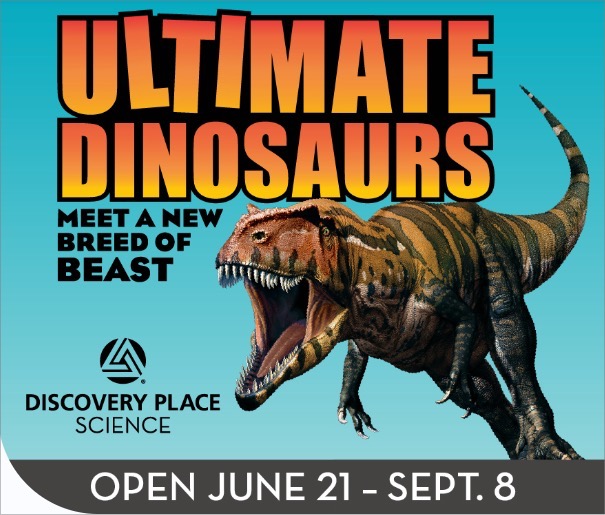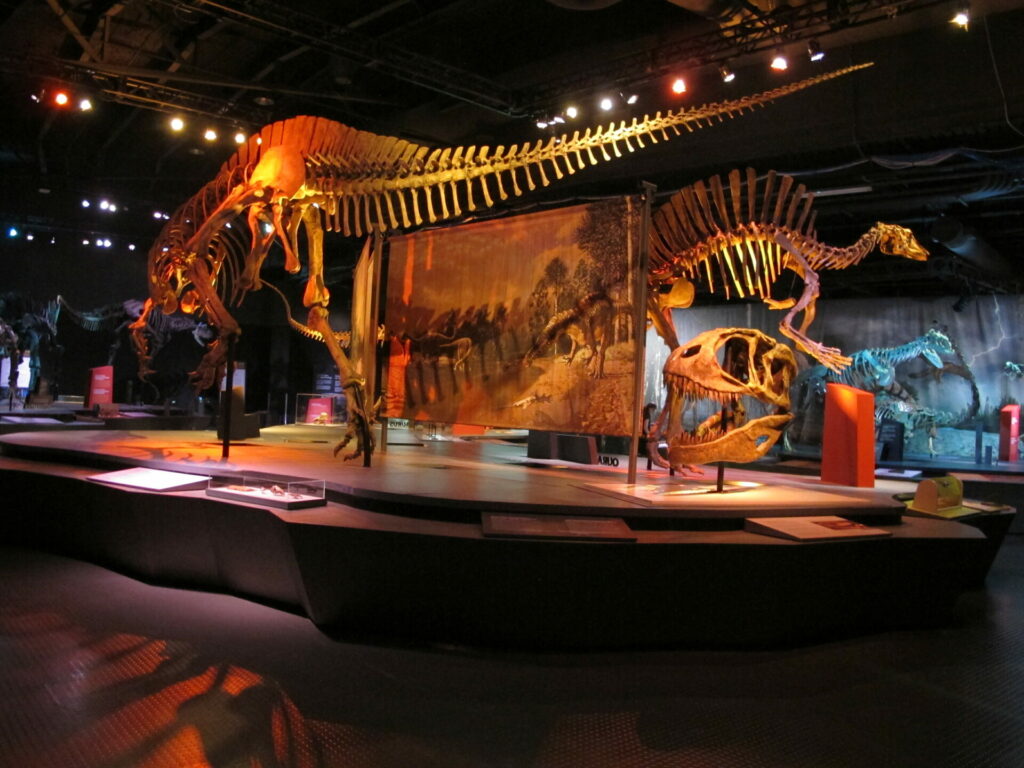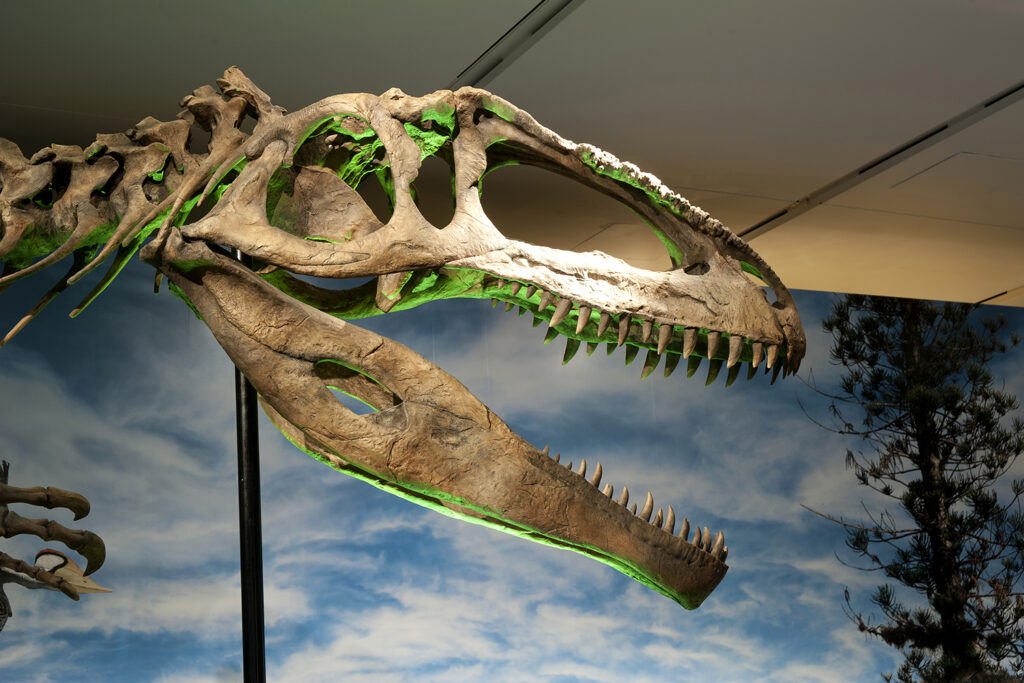Are you a dinosaur fan? If everything you’ve ever wanted in a science exhibit contained large teeth, long claws, and a physique larger than your house, we have exactly what you’re looking for! We think you should plan a summer dino-tour from the NC Museum of Natural Sciences in Raleigh to Discovery Place Science in Charlotte to soak in all of that extreme dinosaur knowledge. North Carolina science centers will not disappoint you this summer!
Read the Press Release below for details on Discovery Place Science’s new “Ultimate Dinosaurs” Exhibit, opening on June 21, 2024. Come meet a new breed of beast!
In Charlotte for a Limited Time: “Ultimate Dinosaurs” Exhibition Roars into Discovery Place Science on June 21 – September 8
Prehistoric creatures from the other side of the world meet cutting-edge technology in this large-scale interactive exhibition.
CHARLOTTE, NC (May 28, 2024) – Prehistory meets 21st century technology when Discovery Place Science opens Ultimate Dinosaurs on Friday, June 21. Featuring 16 fully articulated dinosaur specimens from the Southern Hemisphere, the exhibition seeks to answer the questions: why are southern dinosaurs bizarre and what makes them unique compared to their North American counterparts?

Ultimate Dinosaurs reveals a breed of dinosaurs, unfamiliar to most North Americans, that evolved in isolation in South America, Africa and Madagascar. Groundbreaking research from around the globe led to these discoveries, and through cutting-edge technological experiences, the specimens are brought to life like never before in this exhibition.
“We are thrilled to showcase this extraordinary exhibition in Charlotte,” said Heather Norton, Discovery Place Chief Science Officer. “Ultimate Dinosaurs isn’t your typical dinosaur exhibition. Through augmented reality, history and science are brought to life to give guests a unique perspective on these rarely seen specimens.”

Photo Credit: TELUS World Science
Ultimate Dinosaurs tells the story of the breakup of supercontinent Pangea into the continents that we know today and the ways that continental drift affected the evolution of dinosaurs during the Mesozoic Era 250-65 million years ago. Dinosaurs were passengers on the drifting land masses as Pangea divided, and guests exploring this exhibition will discover that an amazing diversity of species evolved because of this phenomenon. Dinosaurs’ imposed geographic locations helped promote their evolution into an incredible array of unusual forms that dominated wherever they lived.
Some of the dinosaurs featured in the exhibition include:
- Eoraptor (pronounced EE-oh-rap-ter) is a bipedal dinosaur that lived about 228 million years ago that had two different kinds of teeth, both serrated and flat, indicating that it was an omnivore.
- Malawisaurus (pronounced mah-LAH-wee-SORE-us) is one of the earliest titanosaurs and a sauropod from Africa. Like most titanosaurs, Malawisaurus had bones in its skin, similar to those in modern crocodiles.
- Suchomimus (pronounced SOO-ko-MY-muss) is a spinosaur from the Sahara Desert in Niger. This animal was 33 feet long and would have weighed more than 6600 pounds.
- Majungasaurus (pronounced mah-JOON-gah-SORE-us) is a theropod from Madagascar. Paleontologists did extensive research on this species of dinosaur determining that, at least some of the time, it demonstrated cannibalistic behavior.
- Rapetosaurus (pronounced rah-PAY-too-SORE-us) is a titanosaur that was named after the mischievous Malagasy folklore giant, Rapeto. As an adult, Rapetosaurus may have been up to 60 feet long.
- Amargasaurus (pronounced a-MARG-oh-SORE-us) is an herbivorous sauropod from Argentina and had a distinctive double row of spines on its neck and back. These colored, spine-like sails may have been used to signal other members of its species.
- Giganotosaurus (pronounced gig-an-OH-toe-SORE-us) is the largest carnivorous dinosaur from Gondwana and perhaps the largest land predator ever. Giganotosaurus is similar in size to Laurasia’s more famous Tyrannosaurus Rex.
In addition to seeing the specimens on view, learning about the adaptations that made these dinosaurs unique and using augmented reality to make them come to life, guests can participate in hands-on activities to explore physical characteristics like crests and frills, stride patterns and more.

Photo Credit: Science Museum of Minnesota
Media are invited to preview Ultimate Dinosaurs on Thursday, June 20 prior to its public opening on Friday, June 21. Please contact Sarah Wheat, swheat@discoveryplace.org, to schedule a walkthrough. Exhibition images for media use are available here. Photo credits are listed on the image description.
Visitor Information
Ultimate Dinosaurs will be on exhibition at Discovery Place Science from Friday, June 21 through Sunday, September 8, 2024. Entrance to the exhibition is included in General Admission, which includes access to the Museum’s permanent exhibits and labs, and free for Members. Purchase tickets online at discoveryplace.org.
Ultimate Dinosaurs is presented by the Science Museum of Minnesota and was created and produced by The Royal Ontario Museum, Toronto.
Media Contact: Sarah Wheat | swheat@discoveryplace.org